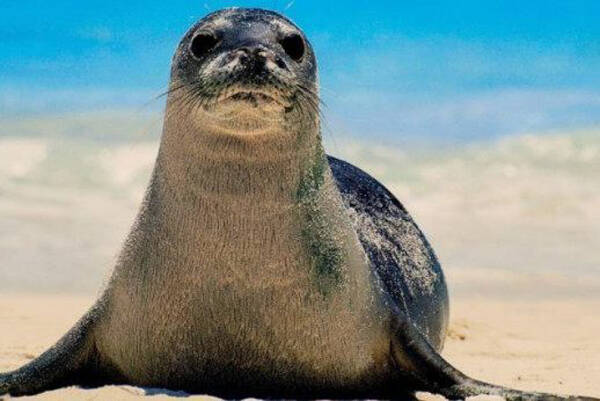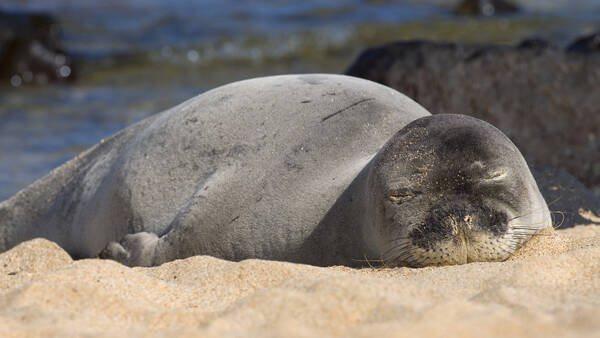Monachus monachus
IUCN
LCBasic Information
Scientific classification
- name:Monachus monachus
- Scientific Name:Monachus monachus,Mediterranean monk sea,Monk seal
- Outline:Carnivora
- Family:Phocaea P.subfamily P.genus
Vital signs
- length:About 2.78 meters
- Weight:250-400kg
- lifetime:20-25 years
Feature
The largest of the monk seals, the rarest seal in the world
Distribution and Habitat
The Mediterranean monk seal is found in the Mediterranean and the Black Sea, and along Northwest Africa to about 34*31 December. Their presence on offshore islands so far suggests at least occasional offshore ventures. On land, they choose rocky coastlines, with a preference for sea caves and caves that are generally inaccessible from land (sometimes with only submarine entrances). In West Africa, they come ashore to swim on open beaches.
Appearance
The maximum body length is 2.78m, the weight is 400kg, and the average weight is 250-300kg. The head is very round and densely covered with short hair, which looks like a monk's head, hence the name. Newborns are black with white spots, and shed their hair in 4-6 weeks. The back of the young animal is silver-gray and the belly is light. Adults are generally dark in color on the back and light on the belly. Some are mostly dark, and some have large white spots on the belly. There is a large variation between individuals, which is a characteristic of this species.
Details
The scientific name of the Mediterranean monk seal is Monachus monachus, and its foreign name is Mediterranean monk seal. It is an ancient and rare seal. Its head is very round and densely covered with short hair, which looks like a monk's head, hence the name. It is the rarest seal in the world.

The Mediterranean monk seal feeds on goatfish, bamboo snapper, sea bream, rays and octopus. They like to forage in waters shallower than 35m. Monk seals prefer tropical warm waters. Their body shape is more suitable for living in water than sea lions and walruses. Their hind limbs cannot bend forward, which is very important for movement in water. The body is smooth and almost streamlined, which is very suitable for fast swimming and diving in the water. The sharp vision and hearing, coupled with the dexterity in the water, make it easier for it to catch various fish. On land, the movements are very clumsy. The limbs that are good at swimming can only play a supporting role, so it has to crawl slowly. The monk seal has black and dense whiskers on its face, and two black eyes are big and bright.
The mating of monk seals is very interesting. Other types of seals mate on the shore or on the ice, but monk seals mate in the water. Once a male seal finds a female seal in estrus, he will chase it relentlessly. When the male seal catches up with the female seal, he will rub the female seal with his body until the female seal agrees to mate. After the two parties reach an "agreement", the wedding ceremony begins. They first stick their heads out of the water and roar at each other, then dive into the water and do a "circle dance". They turn left and right, leaving a long tail wave behind them. The male and female seals turn their heads and bite each other from time to time during the rolling process. At a certain point in the wedding, the female seal will suddenly dive and hide in the uneven rock cracks on the seabed. The male seal will follow closely behind. The female seal fills the entire rock crack. The male seal also wants to squeeze in, but there is no way. Finally, the male seal bites the female seal's tail, pulls it out of the crack, presses its belly down on the sand and rides on it. At this time, the female seal, which was originally running back and forth and restless, suddenly becomes docile and lies motionlessly on the bottom of the water waiting for mating. About 1 minute later, the male and female seals separate, and the mating is completed. The male and female seals who have completed their tasks then swim away separately and have no more ties in the future.

The Mediterranean monk seal has a very long birthing period, from May to November, up to 7 months, with a peak period from September to October. They like to give birth in caves and mate in water, with one male and multiple females.
Protecting the Mediterranean monk seal population is of great significance to protecting the marine and coastal ecosystems. Due to human and natural factors such as fishing activities, hunting, pollution and toxic plankton, the population of Mediterranean monk seals in the eastern Atlantic Ocean is decreasing. There are only about 500 Mediterranean monk seals in the wild in the world. The Convention on the Conservation of Migratory Species of Wild Animals lists this species as one of the critically endangered marine mammals, requiring countries to ban the capture and hunting of seals, protect their habitats, and take preventive measures against other factors that may threaten their survival.
October 18, 2007 Under the support of the United Nations Environment Programme's Convention on the Conservation of Migratory Species of Wild Animals, Mauritania, Morocco, Portugal and Spain recently signed a memorandum of understanding to protect the Mediterranean monk seal in the eastern Pacific Ocean. UNEP hopes that all Atlantic countries will join the ranks of protecting this rare species.
Listed in Appendix I of CITES.
It was approved as a Class 2 protected aquatic wildlife in China on October 9, 2018.
Protect wildlife and eliminate game.
Maintaining ecological balance is everyone's responsibility!








